6 Ways to Use Reviews in Your Content and Pitfalls to Avoid
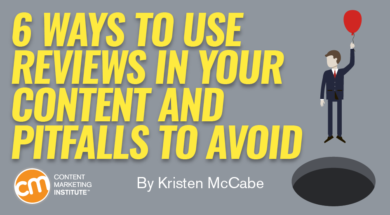 Want a shortcut to creating content that will convert, resonate with your customers, and save you time?
Want a shortcut to creating content that will convert, resonate with your customers, and save you time?
Enter third-party review websites.
For content marketers, reviews are like an unending recipe book. They are your golden ticket to efficient content that converts. (A 2017 study by the Spiegel Research Center reports that displaying reviews can increase conversion rates by up to 270%.)
Displaying reviews can increase conversion rates by up to 270% via @SpiegelResearch.
Click To Tweet
Let’s explore six ways to incorporate reviews into your content marketing strategy and how to avoid the pitfalls.
1. Spark content ideas
Review sites can be a springboard for content ideas – ideas that already reflect something your audience thinks, whether it’s about how to use your product, what features matter, or pain points to overcome.
Review sites can be a springboard for #content ideas, says @AusmericanGirl.
Click To Tweet
This Yelp review for the Tortoise Supper Club in Chicago is full of content ideas. Its marketers could create content about pre-show restaurants, the role of staff in creating ultimate dining experiences, or even the evolution of mom’s meatloaf.
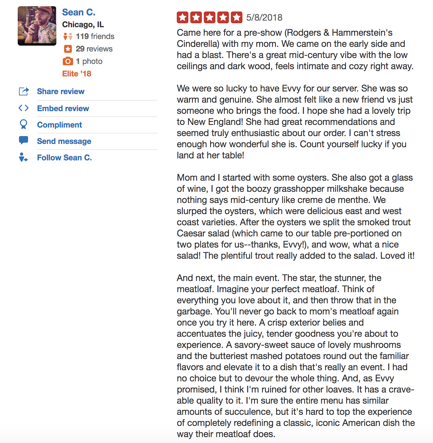
You also can use these reviews as a source to find your brand advocates, who may be willing to work with you to create trustworthy content that converts, such as case studies.
TIP: Use widgets to embed reviews from a third-party platform on your site, which allows consumers to know the review is unaltered.
2. Add credibility to website and landing pages
Incorporate reviews and recognition from review websites on your site. Content from third-party review sites adds a level of credibility. Focus on landing pages with the most traffic or the best leads to conversions.
#Content based on third-party review sites adds a level of credibility, says @AusmericanGirl.
Click To Tweet
In B2C service reviews, TripAdvisor and Yelp allow you to embed reviews at no charge. Embedding from B2B review sites may be open only to paid customers.
Julie’s Park Café & Hotel in Door County, Wisconsin, uses its TripAdvisor reviews on its site:
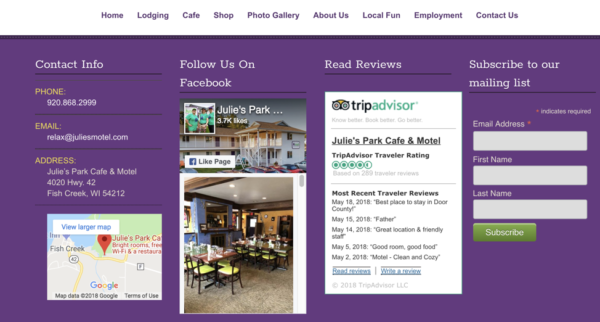
Another Door County hotel, the Bay Shore Inn, uses its TripAdvisor recognition, an instant stamp of approval, on its site:

3. Craft celebratory blog posts
You know those reports and best-of lists created by review sites? As soon as you discover your brand is on the list (yay!), write a blog post displaying the evidence of your new acclaimed status.
Many B2B software providers do this, such as in this example from Kareo, when its all-in-one medical software product was ranked highest in customer satisfaction based on user reviews submitted through G2 Crowd (my employer).

TIP: You also can use reviews to identify keywords to elevate in your blog posts.
4. Watch for videos
As the rise of video reviews continues, keep an eye out for ways to incorporate them in your video content.
For example, if you’re a dog lover like me, you can turn to YouTube for reviews of a pet toy’s durability. Introducing the Tough Toy Tryouts channel. Pet lovers can actually see what happened with the KONG Goodie Bone & Stuff’N Dog after 3-year-old Story put it to the test.
YouTube is a growing source for reviews and Amazon is exploring video reviews too.
5. Share on social media
From LinkedIn to Twitter, reviews give you a great snippet to summarize your story to social media followers. Whether you take a review and turn it into a Twitter testimonial or share on LinkedIn your ranking on a B2B review site, the brief, easy-to-create pieces of content grab attention and drive potential customers to your website.
Create #content snippets from customer reviews to grab attention from #socialmedia followers. @AusmericanGirl
Click To Tweet
Author Lilly Adam took an Amazon review of her book and turned it into a GIF for Twitter:
What a great story of the life of the two girls. It was like a suspense story with all the challenging happenings. Thank you Lilly. NOW ONLY 99p – Amazon Review #mustread #allauthor available at Amazon –> https://t.co/608J23uqgM pic.twitter.com/WnZADMa4L8
— Lilly Adam (@lillya1960) June 17, 2018
6. Print signage
You can use non-verbal review recognition with customers who interact with your brand on location. Yelp, for example, gives businesses the ability to fill out a form and request a Find Us On Yelp sticker. It also automatically sends a People Love Us On Yelp window cling to small businesses that qualify.
Chicago bar Jazz Showcase makes the most of these review site clings:
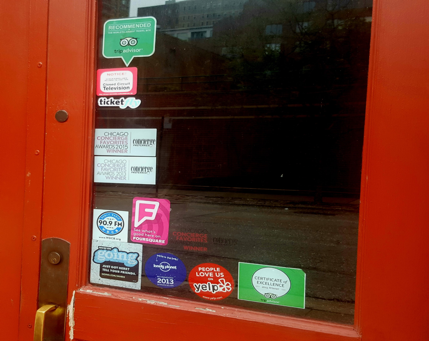
B2B companies can use their awards and recognition at trade shows and expos as Terminus did at the 2018 Marketo Summit:

Avoid these pitfalls
For your review-based content to be credible, the reviews must be credible too – 100% authentic (i.e., the reviewer has used the product or service) and unbiased (i.e., the reviewer wasn’t incentivized or a friend/family member of the business’s employees).
Only use reviews that are 100% authentic and unbiased, says @AusmericanGirl.
Click To Tweet
Some fake reviews are obvious, some not so much. A 2017 BrightLocal study shows 79% of surveyed consumers say they’ve spotted a fake review in the past year. However, 84% of respondents concede they can’t always recognize a fake review.
79% of surveyed customers say they’ve spotted a fake review in the past year via @bright_local.
Click To Tweet

Smart and ethical marketers know they should only use authentic reviews, but even the less ethical should care about the truth. They are more likely to get caught today, as companies are being created or offering services to analyze how trustworthy a review is. For example, ReviewMeta.com was created to evaluate Amazon customer reviews.
TIP: Don’t give away product in exchange for reviews. Invite all your paying customers to write reviews, not just the ones you think will give a positive one. (The Spiegel Research Center study reveals that a perfect or close-to-perfect review score is not perceived as ideal. That number falls between 4.2 and 4.7 on a 5-point scale.)
Don’t assume you have the marketing rights
Just because someone has written a review about your product or service, you don’t automatically have the rights to it.
Some sites allow you to use customer reviews in your marketing materials. Others don’t permit it or charge a fee to do so. You often can find an abundance of information by going to the website where the review was written. Yelp supports businesses using its reviews in their content as long as the community guidelines are followed:
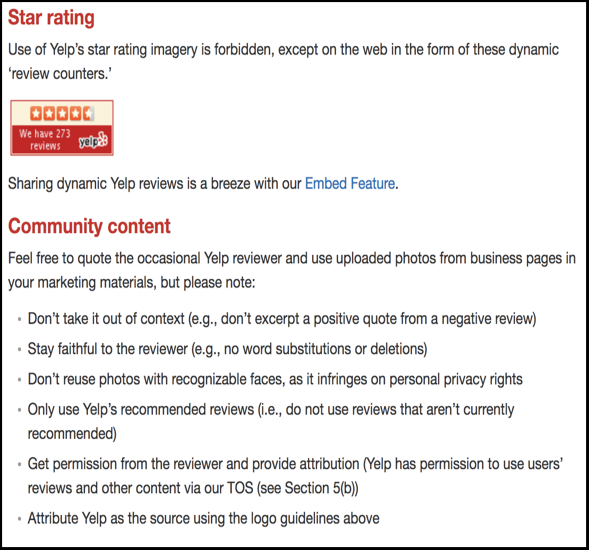
If you’re not sure, reach out and ask about the usage guidelines, terms, and conditions for the site. Emailing the company that hosts the reviews is a great way to get clarification in writing.
TIP: Follow the law too. The U.S. Federal Trade Commission is cracking down on misleading or untruthful endorsements (and that includes failing to disclose if the reviewer was incentivized).
In closing
Once you reflect, it becomes apparent how dependent consumers have become on peer opinions. The good news is your brand can use this feedback. The process of implementing a review strategy (and getting all those reviews!) can take time, but the payoff is worth it.
And imagine how review content can help give you an endless bounty of new content to kick-start ideas and build on content you already have.
Editor’s note: We appreciate G2 Crowd’s support of Content Marketing Institute as a paid benefactor. This article was reviewed and edited independently to ensure that it adheres to the same editorial guidelines as all blog posts.
Please note: All tools included in our blog posts are suggested by authors, not the CMI editorial team. No one post can provide all relevant tools in the space. Feel free to include additional tools in the comments (from your company or ones that you have used).
See who’s using reviews on-site (and learn a lot) at Content Marketing World Sept. 4-7. Register today and use code BLOG100 to save $100.
Cover image by Joseph Kalinowski/Content Marketing Institute
The post 6 Ways to Use Reviews in Your Content and Pitfalls to Avoid appeared first on Content Marketing Institute.
from Content Marketing Institute https://ift.tt/2tv3XT5
via IFTTT





Leave a Comment